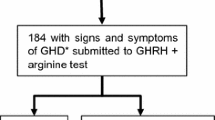Abstract
Primary empty sella (PES) is a very frequent neuroradiological finding in the general population, that can induce hypopituitarism. Some studies focused on the association of PES with GH deficiency (GHD) or hypogonadotropic hypogonadism (HH), while data regarding the involvement of hypothalamic-pituitary-thyroid (HPT) axis, despite sporadic reports of central hypothyroidism, or the occurrence of hypoadrenalism (HA) are scanty. In this study, thyroid function and TSH response to exogenous TRH injection (TRH/TSH) were investigated in 43 patients [10 men and 33 women; aged (mean ±SD), 48±12 yr] with PES: 22 patients had total and 21 partial PES. Forty healthy subjects (9 men and 31 women; aged 46±12 yr) were enrolled as a control group. Central hypothyroidism was found only in 2/43 cases, whereas one patient showed primary hypothyroidism. In euthyroid patients, mean serum TSH levels were significantly lower than controls (TSH: 1.0±0.7 vs 1.4±0.6 mU/l, p<0.01) and 79% of them showed abnormal TRH/TSH responses (TRH test was performed in 34 euthyroid patients: 17 cases with total and 17 cases with partial PES), but mean serum free T4 (FT4) and free T3 (FT3) values were not significantly lower than controls (FT4: 15.9±0.4 vs 15.0±2.1 pmol/l, p=NS; FT3: 5.3±1.2 vs 5.8±1.5 pmol/l, p=NS). Moreover, no significant differences were evident in mean serum TSH, FT4 and FT3 between patients with total and partial PES (TSH: 1.1±0.7 vs 0.9±0.8 mU/l, p=NS; FT4: 16.3±2.6 vs 15.7±2.2 pmol/l, p=NS; FT3: 5.4±1.3 vs 5.2±0.8 pmol/l, p=NS) and the TRH/TSH peak was impaired or exaggerated/delayed in 9 and 3 patients with total and in 12 and 3 cases with partial PES. No significant differences in the prevalence of abnormal TRH/TSH responsiveness were found between patients with partial or total PES (χ2=1.6, p=NS). Other impairment of pituitary function was detected in 23/43 patients: GHD was present in 15 cases, HH in 11 and central HA in 5 patients. Isolated or combined hypopituitarism was present in 17 and in 6 patients, respectively. In conclusion, pituitary dysfunction is very frequent in patients with PES, but central hypothyroidism occurs rarely. The entity of arachnoid herniation into the sellar fossa does not play a significant role on the degree of HPT axis dysfunction.
Similar content being viewed by others
References
Bozzao L., Giuliani M.S., Bastianello S. The herniation of chiasmatic cistern in the sellar cavity. Panminerva Med. 1988, 30: 221–224.
Ducos M., Labarthe F., Latapie J.L. Les selles turciques vidées. Bordeaux Med. 1977, 10: 363–366.
Faglia G., Ambrosi B., Beck-Peccoz P., Giovanelli M.A. Disorders of growth hormone and corticotropin regulation in patients with empty sella. J. Neurosurg. 1973, 38: 59–64.
Brismar K., Efendic S. Pituitary function in the empty sella syndrome. Neuroendocrinology 1981, 32: 70–77.
Buchfelder M., Brockmeier S., Pichl J., Schrell U., Fahlbusch R. Results of dynamic endocrine testing of hypothalamic pituitary function in patients with a primary “empty” sella syndrome. Horm. Metab. Res. 1989, 21: 573–576.
Sastre J., Herranz de la Morena L., Megia A., et al. Primary empty sella turcica: clinical, radiological and hormonal evaluation. Rev. Clin. Esp. 1992, 191: 481–484.
Bianconcini G., Bragagni G., Bianconcini M. Primary empty sella syndrome. Observations on 71 cases. Recenti Prog. Med. 1999, 90: 73–80.
Ekblom M., Ketonen L., Kuuliala I., Pelkonen R. Pituitary function in patients with enlarged sella turcica and primary empty sella syndrome. Acta Med. Scand. 1981, 38: 31–35.
Degli Uberti E.C., Teodori V., Trasforini G., et al. The empty sella syndrome. Clinical, radiological and endocrinologic analysis in 20 cases. Minerva Endocrinol. 1989, 14: 1–18.
Pompili A., Calvosa F., Appetecchia M. Evolution of primary empty sella sindrome. Lancet 1990, 336: 1249.
Luboshitzky R., Barzilai D. Primary empty sella syndrome and hypopituitarism associated with primary hypothyroidism. J. Endocrinol. Invest. 1981, 4: 213–216.
Gharib H., Frey H.M., Laws E.R. Jr., Randall R.V., Scheithauer B.W. Coexistent primary empty sella sindrome and hyperprolactinemia. Report of 11 cases. Arch. Intern. Med. 1983, 143: 1383–1386.
La Franchi S.H., Hanna C.E., Krainz P.L. Primary hypothyroidism, empty sella and hypopituitarism. J. Pediatr. 1986, 108: 571–573.
Okuno S., Inaba M., Nishizawa Y., Miki T., Inoue Y., Morii H. A case of hyponatremia in panhypopituitarism caused by the primary empty sella syndrome. Endocrinol. Jpn. 1987, 34: 299–307.
Author information
Authors and Affiliations
Corresponding author
Rights and permissions
About this article
Cite this article
Cannavò, S., Curtò, L., Venturino, M. et al. Abnormalities of hypothalamic-pituitary-thyroid axis in patients with primary empty sella. J Endocrinol Invest 25, 236–239 (2002). https://doi.org/10.1007/BF03343996
Accepted:
Published:
Issue Date:
DOI: https://doi.org/10.1007/BF03343996




